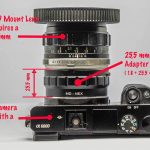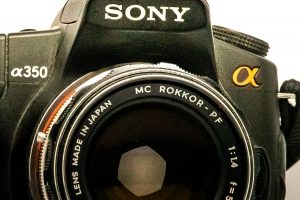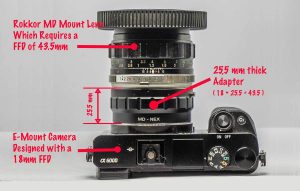Can Sony really make a full-frame dSLR? Not will Sony…but CAN Sony really do it?
Some months back, I wrote that I expected the so-called “flagship” Sony Alpha (possibly named the A900?) to carry a full-frame sensor. I still believe that to be true, however I’m hedging my bets a little. It will be “almost” full-frame or “close” to full-frame. It may not be the actual size of a 35mm negative, however, which is the definition of a full-frame dSLR to most photographers.
It isn’t that Sony lacks the technology to build an actual full-frame sensor. Sony has the ability to build just about any sensor they could wish.
Super Steady Shot doesn’t play well with a full frame sensor
The problem is the Super Steady Shot (anti-shake) system. Not that there is anything wrong with SSS itself, the in-body image stabilization is one of the Sony Alpha dSLR’s major advantages. However, one of the Alpha’s other major advantages is that it can use the extensive line of Minolta A-mount autofocus lenses. And thereby hangs a tale.
Twenty-some years ago, when Minolta engineers were designing the original A mount glass, there were no digital SLRs and no anti-shake systems. Thus, there was no reason to design a lens to cover anything other than the standard 35mm film image.
Thus the AF A mount lenses were designed to project a circle that would encompass a 24 X 36mm area at the camera’s film plane. There was no need to cover a larger film plane, because no Minolta SLR offered a larger negative size.
Maxxum 7D and Antishake: no worries
When Konica Minolta engineers developed the Maxxum 7D, they designed an in-body anti-shake system. The system works by moving the camera’s sensor in relation to camera movement. In essence, if there is camera vibration, the sensor stays in one place, despite the lens and body movement. The same system is used in the Maxxum 5D, the Sony Alpha A100 and the Alpha A700. All of these dSLRs use a 17 X 23mm APS-C sensor.
See the problem? If Sony develops a 24 X 36mm full frame sensor, any lens will need to cover an area larger than 36mm — at least when SSS is turned on. If vibration occurs in an up and down motion, there is room for the sensor to move in relation. If, however, the sensor moves to the left or right, it could move outside of the area covered by the lens. Update: I was in error about room for up and down motion. See these remarks by an optical engineer to understand why the image would be clipped in any direction the sensor moves.
This isn’t an issue with the current Sony/Minolta dSLRs, since the smaller APS-C sensor has plenty of room to move in any direction without moving outside of the lens coverage. When you move up to a full frame sensor, however, there isn’t nearly as much breathing room.
Lens coverage varies
Of course lenses vary. Some of the existing Sony/Minolta lenses may offer enough coverage to allow the SSS system to move — but others would probably exhibit some vignetting if the sensor moves too far to the left or right. Who wants to drop a ton of cash on a professional dSLR when many (most?) of the available lenses might display some vignetting?
How will Sony handle the full frame design?
Sony can tackle this problem in a number of ways. The first could be to drop SSS for the flagship model. That makes little sense, since Sony would then have to develop a line of image stabilized lenses. If they are going to develop an entirely new lens line, they might as well design larger coverage lenses and retain the in-body image stabilization.
Neither of these options are very credible, however. As I said, one of the Sony Alpha’s major selling points is that you can use those millions of Minolta A-mount lenses. Start redesigning the lenses and there is far less reason to choose the Alpha over the competition.
The rumor sites are suggesting that Sony could eliminate any vignetting problem by reducing the sensor size. The sensor could still be much larger than the current 1.5 crop sensor, but not exactly the size of a 35mm film negative. The figure bandied about is 1.1 crop. That would indicate a sensor of something like 21.6 X 32.4mm.
I want my super wide angle lens back!
Loosing 3mm on the width and 2.5mm on the height doesn’t seem like a lot — but it will affect the camera’s ability to display the widest angle of view with current lenses. One of the biggest problems with the APS-C sensor is that most of the original A-mount wide angle lenses aren’t very wide any longer. Cropping a 35mm lens to APS-C size yields something equivalent to the “standard” 50mm lens on a full frame camera. A 24mm lens is now closer to a 35mm. Even a 16mm fisheye is will only show what you would see with a 24mm lens on a full frame camera.
So one of the prime reasons for choosing a full frame camera is to make all those Minolta wide angles truly wide again. A 1.1 crop would be much better than a 1.5 crop in this regard — but is it enough? That 16mm would now be equivalent to 17.6. A 35mm would look like a 38.5 lens.
Those differences seem fairly insignificant, but there are times when you need the widest angle of view you can get. I hate to give up even a millimeter when I am working with an extreme wide angle.
There is one other option that Sony could adopt. Create a full frame 24mm X 36mm sensor and allow the camera to use the full sensor only when SSS is turned off. Turning on the image stabilization would automatically turn off the outer ten percent of the sensor. This would give the best of both worlds. When SSS is engaged, the sensor size is reduced so there is no chance of movement causing vignetting. Turn the image stabilization off and you get the entire full frame area and the ability to shoot at your lenses widest field of view.
Taking a page from Nikon’s book?
This isn’t as far fetched as it seems. Until recently, Nikon didn’t have any full frame cameras in it’s line up, and they sold a ton of APS-C type lenses to go with their 1.5 crop dSLRs. With their all new full-frame D3, Nikon users who owned a bag full of 1.5 crop lenses faced a big problem. “Big N” sidestepped the issue of the APS-C lenses not covering the FF sensor with a switch that reduces the sensor to APS-C size when shooting with a 1.5 crop lens.
Sony could do the exact same thing with their offering, simply reducing the sensor to 90% when SSS is turned on. Of course to be truly useful, there would need to be some way of indicating the crop area in the view finder. This would probably be in the form of engraved lines on the ground-glass to show the crop area.
Would this be worth it? I’m not sure it would be worth the trouble and cost — but it would sure be slick.
If you were on the Sony design team, how would you handle this issue?










Nice article on potential Sony-Minolta FF DSLRs! I saw it in my blog’s Blog Rush widget.
For Sony is one more solution and it is to increase the sensor size for 10% it means ‘corp’ factor 0.9! I suppose this solution is not for the next year model A900/800, because of price. Sony have no market for 7000 USD cameras and it will did as much compromises as could.
Congratulations on the best article regarding this issue that I have read.
I would have a three phase approach with the first two as you say. That would be – full frame with no SSS and second – 1.1 crop factor with SSS. Lastly and not to forget the APS size lenses, a 1.5 crop factor inner sensor boundary to accomodate all the APS lenses. The last would be switchable and at 50% of the full size sensors pixel count. If the full sensor size was 20 MP than the inner APS would be at 10 MP (that is just the way the math and geography work out).
Congratulations on the best article regarding this issue that I have read.
I would have a three phase approach with the first two as you say. That would be – full frame with no SSS and second – 1.1 crop factor with SSS. Lastly and not to forget the APS size lenses, a 1.5 crop factor inner sensor boundary to accomodate all the APS lenses. The last would be switchable and at 50% of the full size sensors pixel count. If the full sensor size was 20 MP than the inner APS would be at 10 MP (that is just the way the math and geography work out).
Which is more important? Fidelity to the 24×36 format or anti-shake? The answer will vary for each photographer. With three A-mount ultrawides ranging from 14 mm to 20 mm, I want full coverage for those lenses. There’s no format concession forced upon Canon 5D users.
Why does there have to be a compromise on the format? Surely Sony knew while they were designing the sensor that they needed to accommodate full frame and anti-shake.
Of course, I will buy the camera, since it will be the only game in town for A-mount owners who want (near) full frame coverage.
Sorry! Should have read the article carefully! As both the author and Mal have recommended, please Sony, give us A-mount UW owners the option to switch off SSS, so we can enjoy the full FOV of those lenses.
Olympus is now introducing the E-3, which has sensor based image stabilisation too, and their sensor is 4% smaller than the sensor of the earlier E-1. I think it’s because of the IS, and a similar FOV crop factor would apply to a “full frame” Sony.
Hope Sony retains the adaptability for Minolta lenses. The ability to turn off SSS would be acceptable. If Sony makes it where I can’t use my existing Minolta lenses then EBay will get my lenses and Canon will get my business!
Has SONY scrapped the 70-200mm f/2.8 G (D) SSM in order to build a TAMRON/SONY cooperative SP AF 70-200mm f/2.8 Di LD (IF) w/ VC for use on the upcoming Full Framer? Oh, would that be a choice move.
Has anyone thought that SONY might be able to make the sensor slightly larger than FF size (to give room for the anti-shake) allowing a capture anywhere on the sensor of FF size?
Would you excuse an Olympus fan to enter a Minolta fan debate ? Allow me to point to the fact that there are no full frame analog cameras that have a negative size of 24mm by 36mm. I have measured several cameras and the negative size range from 23.4mm x 35.1mm to 23.9mm x 35.8mm with 23.7mm x 35.7 as the average. Why not try to measure your Minoltas ?
The best I read so far. Would the a900 be considered a professional DSLR amongst the Canon and Nikon purists. I would really like to know what you think about the pro vs enthusiast camera articles.
http://www.majidart.com
+98-9122043001
Sony’s displaying an updated version at the Photo Imaging Expo in Japan, and reps are apparently now saying that the 24.6 megapixel DSLR will be launched during IFA in August or Photokina in September. Other than that, there’s not much we didn’t already know — which means there’s really not that much at all — but there are some more shots of this nifty clear-bodied display unit at the read link for your ocular delight
Reports are coming in that Park Camera in the UK have presales set for 4000EU ($4,450 US Dollars)! I know Sony wants to demand respect… but come on… make the damn camera fall into the hands of more users! Theyre approach is that Pros will switch because of the MP count! The truth is – Pros would not switch regardless! They would more likely to Augment theyre systems if they’re already satisfied! Sony has gotta get on the ball guys. I say, lets yell at em to get an alpha A850 thats 12 or 14MP at 6fps up to the fill of the card with SS at a $2,000 price tag! I love Minolta/Sony, but I just think that if sony releases this camera at this price it would be a real waste.
Reports are coming in that Park Camera in the UK have presales set for 4000EU ($4,450 US Dollars)! I know Sony wants to demand respect… but come on… make the damn camera fall into the hands of more users! Theyre approach is that Pros will switch because of the MP count! The truth is – Pros would not switch regardless! They would more likely to Augment theyre systems if they’re already satisfied! Sony has gotta get on the ball guys. I say, lets yell at em to get an alpha A850 thats 12 or 14MP at 6fps up to the fill of the card with SS at a $2,000 price tag! I love Minolta/Sony, but I just think that if sony releases this camera at this price it would be a real waste because only Nikon and Canon could do that and users wont complain about the price… technically Sony is new to the DSLR biz… build a flawless rep and give more than the competition to make more users before you hit people like this.
Haha ^^ nice, is there a section to follow the RSS feed
The Sony A900 has to rank among the most anticipated digital SLRs in recent memory.the Alpha A900 featuring a full 35mm frame-sized image sensor, Sony has joined a rather exclusive club. To date only four companies have offered full-frame digital SLRs. .
The Sony Alpha A900 has a whopping 24.6-megapixel resolution from its full-frame Exmor CMOS image sensor — the highest sensor resolution of any 35mm digital SLR yet announced. To handle all the data produced by the high-resolution imager, the Sony DSLR-A900 uses dual Bionz image processors, and this allows for five frames-per-second shooting for up to 11 JPEG or 13 RAW frames.
The sensor is mounted on a moving platter that allows for in-camera image stabilization, branded as SteadyShot Inside. That’s another world’s first for a full-frame digital SLR, and it’s no mean feat when you consider that the sensor shift mechanism has to deal with the extra weight of a full-frame sensor. The various DSLRs seen to date that feature sensor shift stabilization all have significantly smaller 1.6x crop sensors. Sony rose to the challenge by designing a new more powerful sensor shift mechanism, and rates the Alpha DSLR-A900 as good for a 2.5 to 4-stop improvement.
The Sony DSLR-A900’s body is constructed from five main magnesium alloy sections, and includes sealing to reduce ingress of moisture between the body panels, as well as at the various control dials and buttons. The Sony A900 has a Sony Alpha lens mount that also accepts Konica and Konica Minolta glass. A large pentaprism sits above the lens mount, both dictating the camera body’s workmanlike visual aesthetic, and providing a very large and bright TTL optical viewfinder with 0.74x magnification. The rear panel features a large 3-inch LCD display with 921,600 dot resolution, equating to VGA (640 x 480) pixel with three R, G and B dots per pixel. This is used solely for reviewing of images, as well as for menus and status display; the Sony Alpha DSLR-A900 doesn’t offer live view capability. There’s also a small top-panel status LCD which indicates remaining shots and battery life, as well as the basic exposure variables.
The Sony Alpha A900 offers ISO sensitivity from 200 to 3,200 equivalent, but is expandable to ISO 100 to 6,400 equivalent. Shutter speeds range from 30 to 1/8000 second, plus a bulb setting, and x-sync is 1/250 second (or 1/200 second when SteadyShot is enabled). Metering is achieved by a 40-segment honeycomb sensor, and you can also choose from center-weighted or spot metering modes. Focusing is achieved courtesy of a a nine-point phase detection autofocus system with f/2.8 dual center cross sensor, and there are also ten supplemental AF-assist points arranged adjacent to the main AF points. There’s no built-in flash in the Sony A900, with the design instead offering a hot shoe and PC flash sync terminal to cater for external flash strobes and lighting setups.